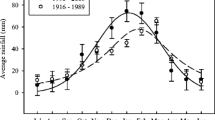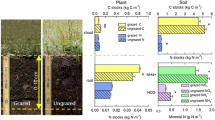Abstract
Long-term grazing by small ruminants diminishes grass and plant covers, alters various biophysical situations and nutrient stoichiometry and modifies soil enzyme activity, and is therefore vital for nutrient cycling in the ecosystem. To apprehend the link between grazing, soil organic carbon (SOC), nutrient cycling enzyme, nutrient stoichiometry and nutrient availability, a grazing study was conducted with 3 different stocking rates (SR1 = 1 adult cattle unit (ACU) ha−1, SR2 = 2ACU ha−1 and SR3 = 3ACU ha−1) in 5 ha of pasture lands and was compared with a control at 5% level of significance under randomized block design. Soil samples were collected from surface and subsurface layers and analysed for SOC and nutrient cycling enzyme, nutrient stoichiometry and their plant availability. In general, pasture productivity under SR1 was significantly higher than SR2 and SR3. SR2 and SR3 significantly depleted SOC (by ~ 20%), nitrogen and sulphur concentration than SR1 and control (P ≤ 0.05) without affecting phosphorus availability. Generally, grazing diminished particulate organic matter-associated C (POMC); however, SR1 significantly increased mineral associated C (MOMC). Grazing significantly altered nutrient stoichiometry in all the soil layers. High grazing pressure significantly reduced dehydrogenase, sulfatase and urease activities over control; however, SR1 boosted activities of phenoloxidase (33%) and peroxidase (32%) over control. Despite that, SR1 recorded ~ 25% lower carbon loss than control; however, SR2 and SR3 had similar carbon loss to control despite having lower SOC in the upper soil layer. Grazing augmented C decay rate (kc) by > 69 and 32% over control in those soil layers, respectively. Grazing with moderate to high stocking rate had a negative impact on SOC, its pools and nutrients. Low stocking rate, i.e., SR1, would sustain SOC and nutrient concentration, and maintain productivity, and hence, could be adopted in the semi-arid tropical regions.



Similar content being viewed by others
References
Abdalla M, Hastings A, Chadwick DR, Jones DL, Evans CD, Jones MB, Rees RM, Smith P (2018) Critical review of the impacts of grazing intensity on soil organic carbon storage and other soil quality indicators in extensively managed grasslands. Agric Ecosyst Environ 253:62–81. https://doi.org/10.1016/j.agee.2017.10.023
Acosta-Martínez V, Bell CW, Morris BE, Zak J, Allen VG (2010) Long-term soil microbial community and enzyme activity responses to an integrated cropping-livestock system in a semi-arid region. Agric Ecosyst Environ 137:231–240. https://doi.org/10.1016/j.agee.2010.02.008
AOAC (1990) Official methods of analysis (15th ed.). Association of Official Analytical Chemists, Washington DC, USA
Badgery WB, Millar GD, Broadfoot K, Michalk DL, Cranney P, Mitchell D, Van de Ven R (2017) Increased production and cover in a variable native pasture following intensive grazing management. Anim Prod Sci 57:1812–1823. https://doi.org/10.1071/AN15861
Cambardella CA, Elliott ET (1992) Particulate soil organic-matter changes across a grassland cultivation sequence. Soil Sci Soc Am J 56:777–783. https://doi.org/10.2136/sssaj1992.03615995005600030017x
Chuan X, Carlyle CN, Bork EW, Chang SX, Hewins DB (2020) Extracellular enzyme activity in grass litter varies with grazing history, environment and plant species in temperate grasslands. Sci Total Environ 702:134562. https://doi.org/10.1016/j.scitotenv.2019.134562
Dick RP (2011) Methods of soil enzymology. Soil Science Society of America, Madison
Fan Q, Wanapat M, Hou F (2019) Mineral nutritional status of yaks (Bos Grunniens) grazing on the Qinghai-Tibetan plateau. Animals 9:468. https://doi.org/10.3390/ani9070468
Franzluebbers AJ, Pehim-Limbu S, Poore MH (2018) Soil-test biological activity with the flush of CO2: IV. Fall-stockpiled tall fescue yield response to applied nitrogen. Agron J 110:2033–2049. https://doi.org/10.2134/agronj2018.03.0146
Franzluebbers AJ, Poore MH, Freeman SR, Rogers JR (2019) Soil-surface nutrient distributions in grazed pastures of North Carolina. J Soil Water Conserv 74:571–583. https://doi.org/10.2489/jswc.74.6.571
Fterich A, Mahdhi M, Mars M (2012) Impact of grazing on soil microbial communities along a chronosequence of Acacia tortilis subsp. raddiana in arid soils in Tunisia. Eur J Soil Biol 50:56–63. https://doi.org/10.1016/j.ejsobi.2011.12.002
Ghosh A, Bhattacharyya R, Meena MC, Dwivedi BS, Singh G, Agnihotri R, Sharma C (2018) Long-term fertilization effects on soil organic carbon sequestration in an Inceptisol. Soil Tillage Res 177:134–144. https://doi.org/10.1016/j.still.2017.12.006
Ghosh A, Kumar RV, Manna MC, Singh AK, Parihar CM, Kumar S, Roy AK, Koli P (2021) Eco-restoration of degraded lands through trees and grasses improves soil carbon sequestration and biological activity in tropical climates. Ecol Eng 162:106176. https://doi.org/10.1016/j.ecoleng.2021.106176
Ghosh A, Kumar S, Manna MC, Singh AK, Sharma P, Sarkar A, Saha M, Bhattacharyya R, Misra S, Biswas SS, Biswas DR (2019) Long-term in situ moisture conservation in horti-pasture system improves biological health of degraded land. J Environ Manage 248:109339. https://doi.org/10.1016/j.jenvman.2019.109339
Ghosh A, Singh AB, Kumar RV, Manna MC, Bhattacharyya R, Rahman MM, Sharma P, Rajput PS, Misra S (2020) Soil enzymes and microbial elemental stoichiometry as bio-indicators of soil quality in diverse cropping systems and nutrient management practices of Indian Vertisols. Appl Soil Ecol 145:103304. https://doi.org/10.1016/j.apsoil.2019.06.007
Ghosh PK, Mahanta SK (2014) Carbon sequestration in grassland systems. Range Manag Agrofor 35:173–181
Hanway JJ, Heidel H (1952) Soil analysis methods as used in Iowa state college soil testing laboratory. Iowa Agric 57:1–31
Haynes RJ (2005) Labile organic matter fractions as central components of the quality of agricultural soils: an overview. Adv Agron 5:221–268. https://doi.org/10.1016/S0065-2113(04)85005-3
Hernández DL, Hobbie SE (2010) The effects of substrate composition, quantity, and diversity on microbial activity. Plant Soil 335:397–411. https://doi.org/10.1007/s11104-010-0428-9
Hewins DB, Fatemi F, Adams B, Carlyle CN, Chang SX, Bork EW (2015) Grazing, regional climate and soil biophysical impacts on microbial enzyme activity in grassland soil of western Canada. Pedobiologia 58:201–209. https://doi.org/10.1016/j.pedobi.2015.10.003
Isermayer H (1952) A simple method for determining soil respiration and carbonates in the soil. Z Pflanzenaehr Bodenkd 5:56–60
Jackson O, Quilliam RS, Stott A, Grant H, Subke JA (2019) Rhizosphere carbon supply accelerates soil organic matter decomposition in the presence of fresh organic substrates. Plant Soil 440:473–490. https://doi.org/10.1007/s11104-019-04072-3
Jiao F, Shi XR, Han FP, Yuan ZY (2016) Increasing aridity, temperature and soil pH induce soil CNP imbalance in grasslands. Sci Rep 6:1–9. https://doi.org/10.1038/srep19601
Keeney DR, Bremner JM (1966) Comparison and evaluation of laboratory methods of obtaining an index of soil nitrogen availability. Agron J 58:498–503. https://doi.org/10.2134/agronj1966.00021962005800050013x
Kirkby CA, Kirkegaard JA, Richardson AE, Wade LJ, Blanchard C, Batten G (2011) Stable soil organic matter: a comparison of C: N: P: S ratios in Australian and other world soils. Geoderma 163(3–4):197–208. https://doi.org/10.1016/j.geoderma.2011.04.010
Klumpp K, Fontaine S, Attard E, Le Roux X, Gleixner G, Soussana JF (2009) Grazing triggers soil carbon loss by altering plant roots and their control on soil microbial community. J Ecol 97:876–885. https://doi.org/10.1111/j.1365-2745.2009.01549.x
Kumar SS (2011) Land accounting in India: issues and concerns. Central Statistics Office, Ministry of Statistics & Programme Implementation, New Delhi, India. https://wesf.pw/1612492322.pdf. Accessed 31 Aug 2021
López-Mársico L, Altesor A, Oyarzabal M, Baldassini P, Paruelo JM (2015) Grazing increases below-ground biomass and net primary production in a temperate grassland. Plant Soil 392:155–162. https://doi.org/10.1007/s11104-015-2452-2
Ma W, Ding K, Li Z (2016) Comparison of soil carbon and nitrogen stocks at grazing-excluded and yak grazed alpine meadow sites in Qinghai-Tibetan Plateau, China. Ecol Eng 87:203–211. https://doi.org/10.1016/j.ecoleng.2015.11.040
Mahanta SK, Ghosh PK, Ramakrishnan S (2020) Tropical grasslands as potential carbon sink. In Ghosh P, Mahanta S, Mandal D, Mandal B, Ramakrishnan S (eds) Carbon Management in Tropical and Sub-Tropical Terrestrial Systems. Springer, Singapore, pp 299–311. https://doi.org/10.1007/978-981-13-9628-1_18
McGill WB, Cannon KR, Robertson JA, Cook FD (1986) Dynamics of soil microbial biomass and water-soluble organic C in Breton L after 50 years of cropping to two rotations. Can J Soil Sci 66(1):1–9. https://doi.org/10.4141/cjss86-001
Mligo C (2015) Conservation of plant biodiversity of Namatimbili forest in the southern coastal forests of Tanzania. Int J Biodivers Conserv 7:148–172. https://doi.org/10.5897/IJBC2014.0771
Oates LG, Undersander DJ, Gratton C, Bell MM, Jackson RD (2011) Management-intensive rotational grazing enhances forage production and quality of subhumid cool-season pastures. Crop Sci 51:892–901. https://doi.org/10.2135/cropsci2010.04.0216
Olivera NL, Prieto L, Carrera AL, Cisneros HS, Bertiller MB (2014) Do soil enzymes respond to long-term grazing in an arid ecosystem? Plant Soil 378:35–48. https://doi.org/10.1007/s11104-013-2010-8
Olsen SR (1954) Estimation of available phosphorus in soils by extraction with sodium bicarbonate (No. 939). US Department of Agriculture
Paz-Ferreiro J, Trasar-Cepeda C, del Carmen LM, Seoane S, Gil-Sotres F (2011) Intra-annual variation in biochemical properties and the biochemical equilibrium of different grassland soils under contrasting management and climate. Biol Fert Soil 47:633–645. https://doi.org/10.1007/s00374-011-0570-4
Prieto LH, Bertiller MB, Carrera AL, Olivera NL (2011) Soil enzyme and microbial activities in a grazing ecosystem of Patagonian Monte. Argentina Geoderma 162:281–287. https://doi.org/10.1016/j.geoderma.2011.02.011
Raiesi F, Beheshti A (2014) Soil specific enzyme activity shows more clearly soil responses to paddy rice cultivation than absolute enzyme activity in primary forests of northwest Iran. Appl Soil Ecol 75:63–70. https://doi.org/10.1016/j.apsoil.2013.10.012
Ritchie ME (2014) Plant compensation to grazing and soil carbon dynamics in a tropical grassland. Peer J 2:233. https://doi.org/10.7717/peerj.233
Roy AK, Singh JP(2013). Grasslands in India: problems and perspectives for sustaining livestock and rural livelihoods. Trop Grassl 1:240–243. http://www.tropicalgrasslands.info/index.php/tgftble. Accessed 31 Aug 2021
Rui Y, Wang Y, Chen C, Zhou X, Wang S, Xu Z, Duan J, Kang X, Lu S, Luo C (2012) Warming and grazing increase mineralization of organic P in an alpine meadow ecosystem of Qinghai-Tibet Plateau, China. Plant Soil 357:73–87. https://doi.org/10.1007/s11104-012-1132-8
Schulz K, Voigt K, Beusch C, Almeida-Cortez JS, Kowarik I, Walz A, Cierjacks A (2016) Grazing deteriorates the soil carbon stocks of Caatinga forest ecosystems in Brazil. Forest Ecol Manage 367:62–70. https://doi.org/10.1016/j.foreco.2016.02.011
Shinde AK, Mahanta SK (2020) Nutrition of small ruminants on grazing lands in dry zones of India. Range Manag Agrofor 41:1–4
Simpson RJ, Stefanski A, Marshall DJ, Moore AD, Richardson AE (2015) Management of soil phosphorus fertility determines the phosphorus budget of a temperate grazing system and is the key to improving phosphorus efficiency. Agric Ecosyst Environ 212:263–277. https://doi.org/10.1016/j.agee.2015.06.026
Stanford G, Smith SJ (1972) Nitrogen mineralization potentials of soils. Soil Sci Soc Am J 36:465–472. https://doi.org/10.2136/sssaj1972.03615995003600030029x
Teague R, Kreuter U (2020) Managing grazing to restore soil health, ecosystem function, and ecosystem services. Front Sustain Food Syst 4:157. https://doi.org/10.3389/fsufs.2020.534187
Tirol-Padre A, Ladha JK (2004) Assessing the reliability of permanganate-oxidizable carbon as an index of soil labile carbon. Soil Sci Soc Am J 68:969–978. https://doi.org/10.2136/sssaj2004.9690
Van Soest PV, Robertson JB, Lewis B (1991) Methods for dietary fiber, neutral detergent fiber, and nonstarch polysaccharides in relation to animal nutrition. J Dairy Sci 4:3583–3597. https://doi.org/10.3168/jds.S0022-0302(91)78551-2
Walkley A, Black IA (1934) An examination of the Degtjareff method for determining soil organic matter, and a proposed modification of the chromic acid titration method. Soil Sci 37:29–38. https://doi.org/10.1097/00010694-193401000-00003
Wardle DA, Bardgett RD, Klironomos JN, Setälä H, Van Der Putten WH, Wall DH (2004) Ecological linkages between aboveground and belowground biota. Sci 304:1629–1633. https://doi.org/10.1126/science.1094875
Worrall F, Clay GD (2012) The impact of sheep grazing on the carbon balance of a peatland. Sci Total Environ 438:426–434. https://doi.org/10.1016/j.scitotenv.2012.08.084
Yong-Zhong S, Yu-Lin L, Jian-Yuan C, Wen-Zhi Z (2005) Influences of continuous grazing and livestock exclusion on soil properties in a degraded sandy grassland, Inner Mongolia, northern China. CATENA 59:267–278. https://doi.org/10.1016/j.catena.2004.09.001
Zhang T, Zhang Y, Xu M, Zhu J, Wimberly MC, Yu G, Niu S, Xi Y, Zhang X, Wang J (2015) Light-intensity grazing improves alpine meadow productivity and adaption to climate change on the Tibetan Plateau. Scientific Reports 5(1):1–12. https://doi.org/10.1038/srep15949
Zhang J, Zhao N, Liu C, Yang H, Li M, Yu G, Wilcox K, Yu Q, He N (2018) C: N: P stoichiometry in China’s forests: from organs to ecosystems. Funct Ecol 32:50–60. https://doi.org/10.1111/1365-2435.12979
Acknowledgements
The authors thank Director, ICAR-IGFRI and the staff of the experimental station for the long-term maintenance of the grazing experiment.
Author information
Authors and Affiliations
Corresponding author
Ethics declarations
Conflict of Interest
The authors declare no competing interests.
Additional information
Publisher's Note
Springer Nature remains neutral with regard to jurisdictional claims in published maps and institutional affiliations.
Supplementary Information
Below is the link to the electronic supplementary material.
Rights and permissions
About this article
Cite this article
Ghosh, A., Mahanta, S.K., Manna, M.C. et al. Long-Term Grazing Mediates Soil Organic Carbon Dynamics by Reorienting Enzyme Activities and Elemental Stoichiometry in Semi-arid Tropical Inceptisol. J Soil Sci Plant Nutr 22, 1422–1433 (2022). https://doi.org/10.1007/s42729-021-00742-3
Received:
Accepted:
Published:
Issue Date:
DOI: https://doi.org/10.1007/s42729-021-00742-3




